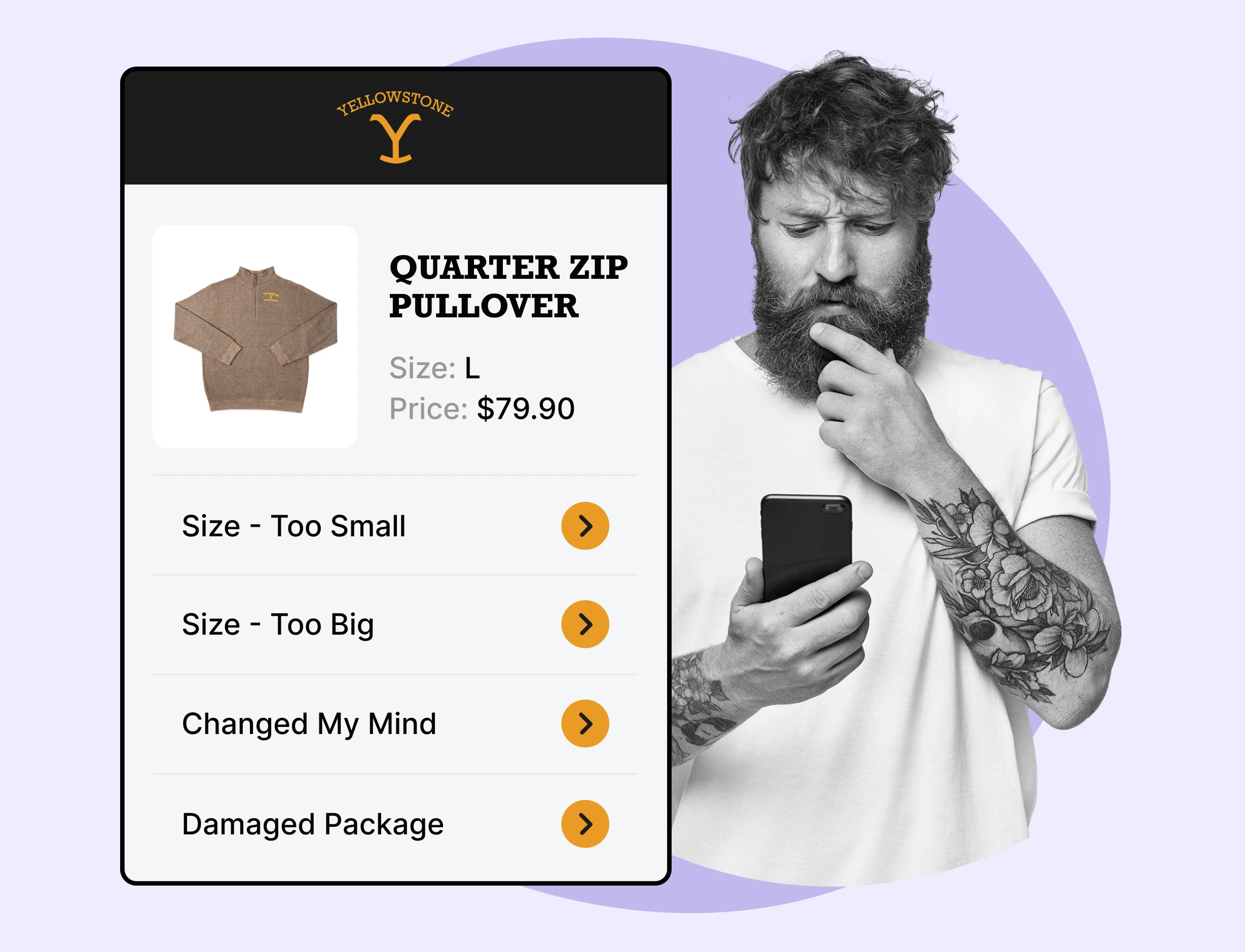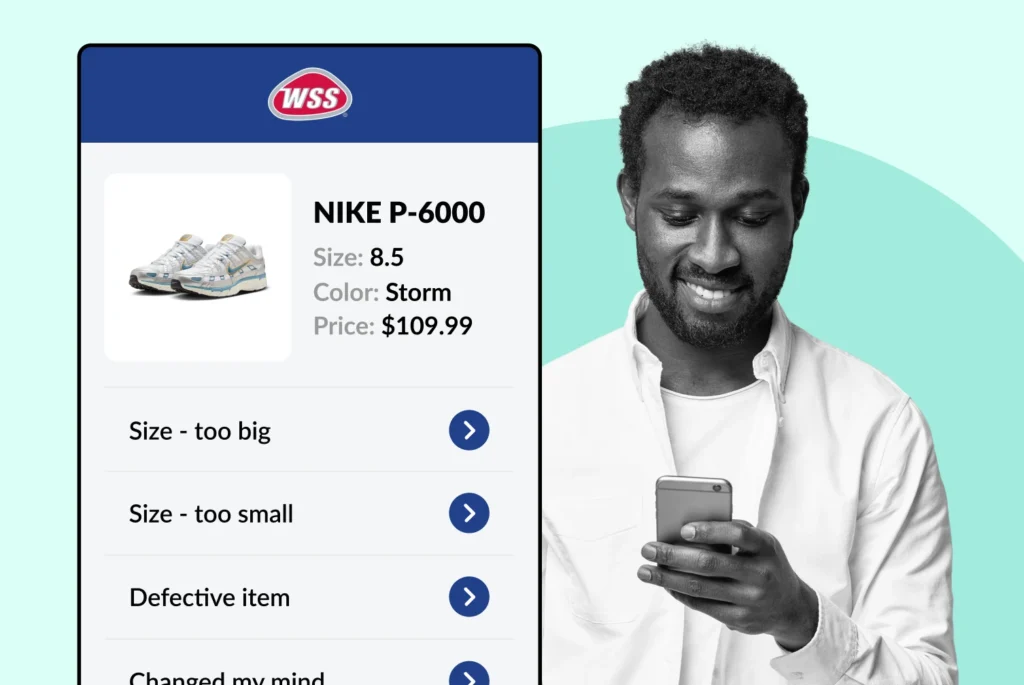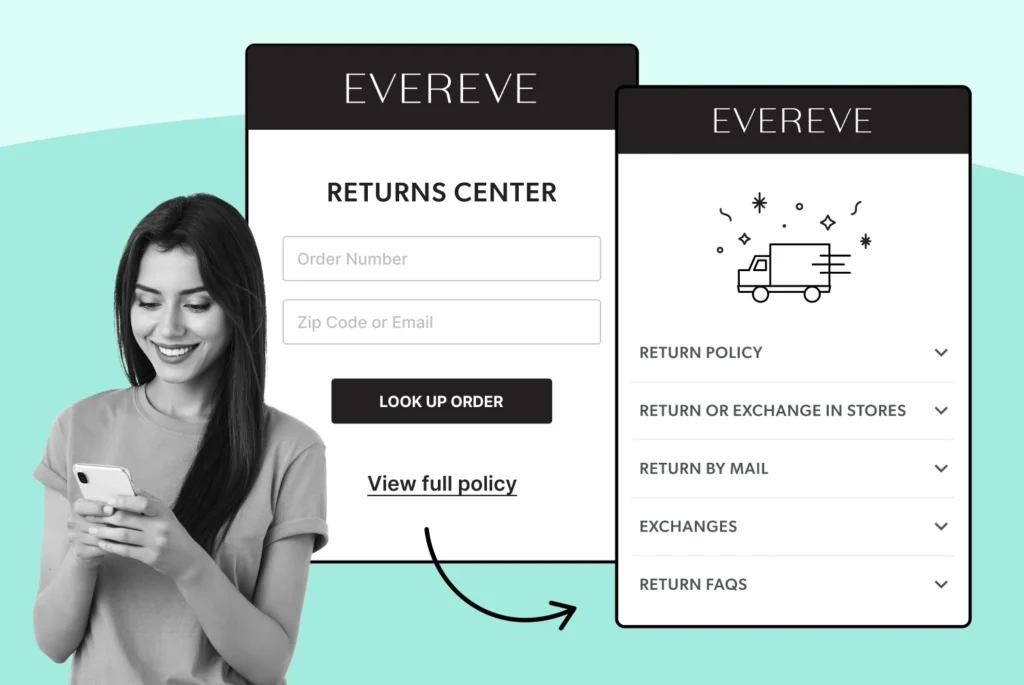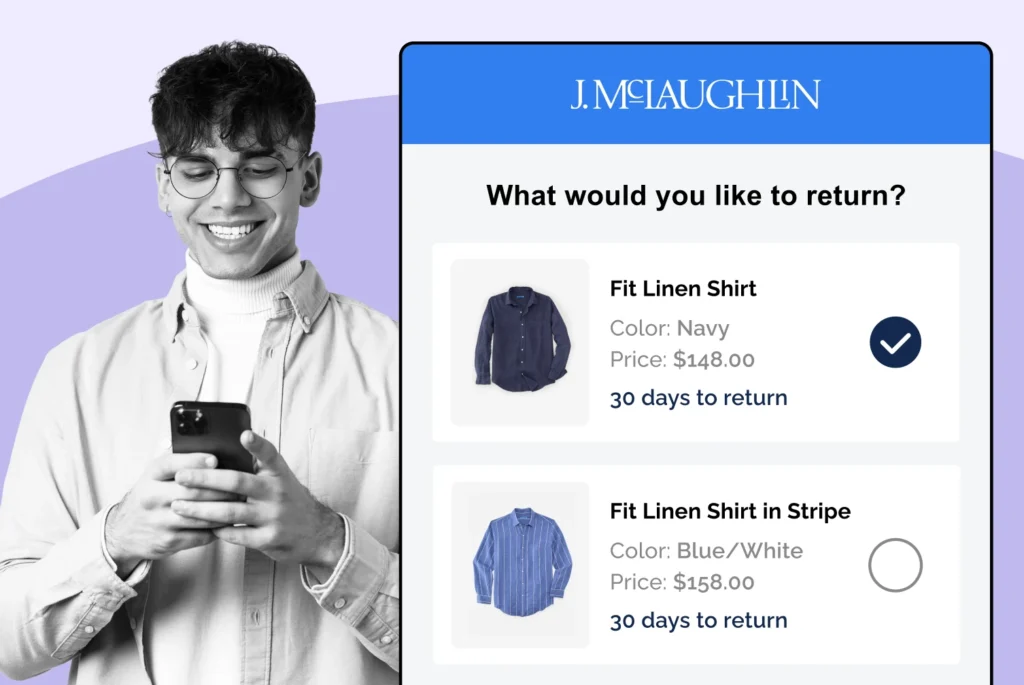
8 Best Practices for an Effective Ecommerce Return Policy
Let’s explore practical return policy strategies for jewelry brands to enhance customer satisfaction and loyalty!
Shipping, Tracking & Notifications
Boost customer experience and reduce support tickets
Realtime order and shipment tracking
Proactive order and shipping notifications
AI-Enhanced Discounted Labels
Predictive pre-purchase estimated delivery dates
Self-Serivce branded order tracking
Effortless experience delivered
Identify and Resolve Order Issues
Realtime order and shipment tracking
Make returns profitable and delight customers
Flexibility to define any return destinations & conditions
Simplify returns for your customers and team
Incentivize exchanges over returns
Returns management made easy for your team
Returns management made easy for your team
Easy claims and smart upsells
Understand why your customers are returning
In-Store & Curbside Pickup
Unify the online and the in-store experience
Hassle-free pickup experience for customers
In-Store dashboard to keep operations streamlined
In-Store and Online orders unified
Drive foot-traffic to your stores
Shipping, Tracking & Notifications
Boost customer experience and reduce support tickets
Realtime order and shipment tracking
Proactive order and shipping notifications
AI-Enhanced Discounted Labels
Predictive pre-purchase estimated delivery dates
Self-Serivce branded order tracking
Effortless experience delivered
Identify and Resolve Order Issues
Realtime order and shipment tracking
Make returns profitable and delight customers
Flexibility to define any return destinations & conditions
Simplify returns for your customers and team
Incentivize exchanges over returns
Returns management made easy for your team
Returns management made easy for your team
Understand why your customers are returning
In-Store & Curbside Pickup
Unify the online and the in-store experience
Hassle-free pickup experience for customers
In-Store Dashboard to keep operations streamlined
In-Store and Online orders unified
Drive foot-traffic to your stores
Boost customer experience and reduce support tickets
Realtime order and shipment tracking
Proactive order and shipping notifications
AI-Enhanced Discounted Labels
Predictive pre-purchase estimated delivery dates
Self-Serivce branded order tracking
Effortless experience delivered
Make returns profitable and delight customers
Flexibility to define any return destinations & conditions
Simplify returns for your customers and team
Incentivize exchanges over returns
Returns management made easy for your team
Equip your team for precise return checks.
Easy claims and smart upsells
Understand why your customers are returning
Unify the online and the in-store experience
Hassle-free pickup experience for customers
In-Store Dashboard to keep operations streamlined
In-Store and Online orders unified
Drive foot-traffic to your stores
Find the answer to all your questions
Take a step by step trip through our functionality to see how we can improve your ecommerce processes.
Explore the most comon questions about WeSupply
Calculate the ROI that WeSupply can bring you
Read actionable articles on how to optimize your post-purchase experience and decrease support tickets
Get inspired by stories of how our customers implemented an effortless post-purchase experience
Wondering if WeSupply is a good fit for you? Read through our use cases to see how we can help you increase conversion & improve CX!
A Deep Dive into Top Companies' Order Tracking & Returns Strategy
Find the answer to all your questions
Explore the most comon questions about WeSupply
Calculate the ROI that WeSupply can bring you
Request a no strings attached review of your current shopping experience and missed conversion opportunities
Take a step by step trip through our functionality to see how we can improve your ecommerce processes.
Read actionable articles on how to optimize your post-purchase experience and decrease support tickets
Get inspired by stories of how our customers implemented an effortless post-purchase experience
A Deep Dive into Top Companies' Order Tracking & Returns Strategy
Wondering if WeSupply is a good fit for you? Read through our use cases to see how we can help you increase conversion & improve CX!

Ecommerce returns are escalating, causing financial strain. But who’s at fault for ecommerce returns? Is it the customers, due to indecision or misuse? Or the retailers, because of poor product descriptions or quality issues? This article explores the major factors behind ecommerce returns and assigns responsibility where it’s due, providing insights for both consumers and businesses.
Ecommerce returns are significantly impacting profits, with rates reaching up to 30% in some sectors, necessitating efficient return management strategies.
Key drivers of returns include sizing issues, buyer’s remorse, and complicated return processes, which retailers must address to reduce return rates.
Retailers need to improve product descriptions, enhance quality control, and offer responsive customer support to manage returns effectively and maintain customer satisfaction.
WeSupply simplifies ecommerce returns with accurate product descriptions, detailed returns analytics, and efficient logistics. Our solutions reduce return rates, manage fraudulent behavior, and streamline order handling, boosting profitability and customer satisfaction. Get Started with WeSupply to optimize your returns management!
Ecommerce returns are a growing concern for businesses across the globe. As online shopping continues to surge, so do the return rates, creating a significant financial strain on retailers. Managing these returns effectively is crucial not only for maintaining customer satisfaction but also for preserving profit margins.
We will explore the escalating challenge of ecommerce returns and provide an overview of the key drivers behind them. Recognizing these factors is crucial for developing strategies to manage and reduce return rates.
The rapid rise in online shopping has led to a significant increase in product returns. Retailers are finding themselves overwhelmed by the sheer volume of returns, which can vary considerably across product categories, with some sectors experiencing rates as high as 30%. A significant portion of these returns is due to customers receiving damaged or defective items. This surge in returns creates financial and operational challenges, with the cost of processing returns often exceeding that of fulfilling original orders.
In 2020 alone, returns from merchandise reached approximately $428 billion, representing about 10.6% of total U.S. retail sales. This highlights the immense scale of the problem and the necessity for retailers to adopt more efficient return management strategies. Ineffective or complicated return processes can lead to customer dissatisfaction, negative reviews, and a drop in repeat business.
Implementing a clear and user-friendly returns policy can enhance customer satisfaction and loyalty. To address these issues, many e-commerce brands are adopting automation to streamline their returns processes, significantly reducing errors and improving efficiency.
Overall, the growing challenge of ecommerce returns demands attention and innovation from retailers to balance customer expectations with operational efficiency and profitability.
Several factors contribute to the high return rates in ecommerce. Common reasons include dissatisfaction with product quality, sizing issues, and customers changing their minds. Product misrepresentation and buyer’s remorse also play significant roles in driving returns.
The ease of return processes significantly influences consumer purchasing behavior, with most shoppers preferring retailers that offer hassle-free returns. Studies indicate that consumers expect free returns as a standard practice. This expectation drives higher online sales but also poses financial challenges for retailers due to increased return rates.
Another interesting aspect is the intentional purchase of multiple sizes or variations of a product with the plan to return all but one. This behavior, observed in approximately 41% of online shoppers, emphasizes the impact of return policies on consumer behavior. Additionally, fraudulent returns, which account for nearly 14% of ecommerce returns, highlight the necessity for retailers to balance customer satisfaction with effective return management systems.
Understanding these key return drivers allows retailers to develop strategies that can reduce return rates while maintaining a positive customer experience.
Customer behavior plays a crucial role in ecommerce returns. Factors like sizing issues, impulse purchases, and dissatisfaction with gifts are common reasons why customers return products. Managing these returns effectively is essential for maintaining customer satisfaction and loyalty.
We will delve into the various ways customer actions contribute to high return rates, including sizing or fit issues in apparel and footwear, impulse purchases, unwanted gifts, and the exploitation of return policies through practices like wardrobing.
Many returns occur because customers experience buyer’s remorse or make impulsive buying decisions. Impulse buying often results from promotional strategies but can lead to an increased likelihood of returns when customers regret their purchases. These purchases are usually spontaneous and not planned, often driven by social influences and fear of missing out.
Research indicates that approximately 50% of online shoppers who use social media have made an impulse purchase in the last three months. However, a significant portion of these consumers, around 56%, express regret over their impulse purchases, which can negatively affect their perception of the brand. Many consumers find returning impulsively bought items challenging, leading them to keep products purchased online that they are unsatisfied with during their online purchases.
Recognizing the role of consumer behavior in impulse purchases enables retailers to develop strategies to minimize returns and improve customer satisfaction.
Items returned as unwanted gifts frequently reflect mismatched expectations or compatibility issues. Items bought as gifts may be returned due to mismatched preferences or incompatibility, creating additional challenges for retailers.
Detailed product descriptions, including size and material information, can significantly reduce returns caused by mismatched expectations. Encouraging customer reviews helps potential buyers make informed decisions, leading to fewer returns due to dissatisfaction. Offering size guides and fit assistance specifically for apparel can enhance customer satisfaction and minimize return rates.
High-resolution product images and videos can provide customers with a better understanding of the item, reducing surprises upon delivery. Strong quality control measures ensure that products are accurately described and free from defects, lowering the chances of returns. Responsive customer support can effectively address concerns, potentially decreasing the likelihood of returns.
Retailers play a crucial role in minimizing return rates by taking proactive steps in product presentation and quality control. Online retailers face an average return rate of 17.6%, significantly higher than the overall retail return rate of 14.5%.
We will explore the various responsibilities retailers have in reducing return rates, including the importance of accurate product descriptions, quality control, managing misleading product information, and handling incorrect orders and delivery delays.
WeSupply enhances the accuracy of product descriptions and sizing guides, which is crucial for reducing returns and improving customer satisfaction. By providing detailed and precise information, businesses can better align customer expectations with actual product attributes.
Returns Analytics offers valuable insights that drive improvements in product offerings:
By leveraging these tools, you can significantly reduce the likelihood of returns and enhance overall customer satisfaction.
Managing incorrect orders and delivery delays effectively is crucial for maintaining customer satisfaction and minimizing return rates. Promptly addressing these issues ensures a smoother experience and reinforces customer trust.
Given that a significant portion of online orders contain errors, often around one-third, and shipping delays can be exacerbated by incorrect customer details or high order volumes during peak periods, it’s vital to manage these challenges efficiently. The cost of return shipping, especially for large or international items, can be substantial, making accurate and timely fulfillment even more critical.
To improve order management and customer experience, WeSupply offers:
Reship/Replace Damaged Products: Automatically reship or replace damaged items, with options for upgrades to maintain customer satisfaction.
Waive Return Fees for Damaged Products: Automatically waive return and restocking fees for damaged products, simplifying the return process and aligning with customer expectations.
By leveraging these features, WeSupply helps streamline order fulfillment, manage delivery expectations, and enhance overall customer experience.
Create custom return policies
here are many moving pieces in ecommerce logistics. Book a quick call with our experts to see how WeSupply can help you take control by creating custom policies to handle them all easily. You get to decide how you want to handle final sale items, return window lengths, return request approvals, and more.
Return fraud significantly impacts retailers, costing them billions annually due to dishonest behaviors like wardrobing. Wardrobing return fraud affects retailers, with about 10.7% of online returns being fraudulent, particularly harming fashion retailers.
In this section, we will explore the types of fraudulent return behaviors, such as wardrobing and serial returning, and discuss strategies to identify and prevent these practices.
Implementing clear return policies and specialized anti-wardrobing tags can effectively deter customers from exploiting return systems. Utilizing digital tools and predictive models helps retailers monitor and manage return fraud, including wardrobing.
Wardrobing involves purchasing items, using them briefly for events, and then returning them for a refund, allowing consumers to use products at no cost. Certain clothing tags can be easily removed and reattached, making it harder to detect abuse in wardrobing practices. The practice of snap-and-send-back is linked to social media pressure, where items are bought, worn for photos, and returned shortly after.
Retailers are increasingly tracking social media accounts of frequent returners to prevent abuse of return policies. The 360 ID Tag is a tamper-evident tool designed to prevent wardrobing and other types of returns fraud while maintaining a good returns experience for honest customers.
Retailers can track serial returners by analyzing purchase histories and return frequencies to identify suspicious patterns. Monitoring customer return behaviors and identifying patterns of serial returning can help retailers combat fraudulent return practices. A significant portion of online shoppers, approximately 67%, are classified as ‘serial returners,’ indicating a tendency to purchase multiple items with the intention of returning some.
Clothing and shoes are among the highest categories affected by serial returners, primarily due to size and fit issues. Retailers are encouraged to provide detailed product descriptions and accurate sizing information to help reduce the incidence of serial returns. Setting specific return conditions and time limits can reduce the chances of serial returning and wardrobing.
Offering a ‘try before you buy’ option can significantly reduce the likelihood of returns by allowing customers to test products beforehand. Requiring identification for returns allows retailers to track customer behavior and identify patterns of excessive returns. While serial returners can cause issues, they often represent the most profitable customers, leading to higher net sales than average shoppers.
WeSupply’s Pre-built Return Policies effectively tackle return fraud by addressing issues like wardrobing and serial returning. Our system helps protect revenue and ensure a fair return process with targeted fraud prevention measures:
WeSupply’s Pre-built Return Policies safeguard your business from return fraud while maintaining a fair return process. Discover how our tailored solutions can enhance your return strategy—explore our other Pre-built Return Policies for more insights and protections!
Reverse logistics involves the entire process of returning products from customers to the retailer and reintegrating the item into inventory. This process is essential for handling product returns efficiently, impacting overall profitability and supply chain effectiveness.
We will explore the complexities of reverse logistics in ecommerce and suggest ways to streamline the return process to improve profitability.
The reverse logistics process requires meticulous tracking and handling of returned items, including sorting them for resale, refurbishment, or recycling. Ecommerce returns pose significant logistics challenges, with many items returned due to damages or improper sizing.
WeSupply addresses these challenges with its Intelligent Dispositions system, optimizing the handling of returns to mitigate costs and environmental impact. By dynamically routing items to the nearest suitable locations—such as warehouses, recycling centers, donation facilities, or outlet stores—WeSupply enhances efficiency and sustainability in reverse logistics.
Key Features:
Dynamic Routing: Optimize returns by directing them to the most appropriate locations based on predefined rules
Environmental Responsibility: Reduce unnecessary transportation and emissions with strategic routing
Efficient Handling: Improve inventory management and minimize disruptions caused by improperly handled returns
WeSupply streamlines the return process to enhance profitability and customer satisfaction by offering efficient and user-friendly solutions.
Key Features:
Branded Returns Portal: Provide a seamless and branded return experience without third-party interference
Self-Service Returns: Allow customers to manage their returns effortlessly, meeting the demand for frictionless processes
Flexible Returns Rules: Create customizable return policies to suit various return scenarios
Autogenerated QR Code Return Labels: Simplify returns with easy-to-use QR code labels, eliminating the need for printing
Returns Tracking: Offer real-time tracking of return progress and status updates
Post-Purchase Notifications: Utilize high-engagement email and SMS notifications to keep customers informed and engaged
Integrations: Connect seamlessly with third-party tools and APIs to enhance the returns experience and optimize costs
WeSupply’s streamlined return process enhances profitability by reducing operational costs and increasing customer satisfaction. By leveraging features like instant credit, branded returns portals, and self-service options, you can boost ROI and drive revenue growth. Discover how much more you could save—use the ROI calculator to see the potential benefits!
Data analytics is crucial for reducing return rates and enhancing customer satisfaction in retail. Strategically collected return data can reveal trends and inform various operational aspects, including product design and customer service.
We will discuss the importance of return data and how analyzing return reasons and patterns can help retailers improve their processes and reduce return rates.
Utilizing data-driven insights from return analytics can greatly enhance your ability to address product issues and refine your offerings. WeSupply’s advanced analytics tools help you identify key return patterns, such as product quality and sizing issues, and leverage customer feedback for continuous improvement.
Key Features:
Identify frequently returned products and understand the reasons for returns
Detect serial returners and use actionable insights to reduce return rates
Access detailed returns data through BigQuery
Harness the power of data to refine your return strategies and enhance customer satisfaction. With WeSupply’s comprehensive analytics tools and feedback integrations, you can effectively address return issues, optimize product offerings, and continually improve your customer experience.
Effective returns policies can significantly influence customer satisfaction and business success, partnering with the rise of ecommerce. These policies can turn customer dissatisfaction into loyalty, significantly impacting overall customer experience.
We will explore how to craft transparent, user-friendly return policies, provide responsive and effective customer support, and offer multiple return options to enhance customer satisfaction.
A user-friendly return policy is essential for building customer trust and simplifying the return process. WeSupply enhances transparency by offering customizable return rules and clear return windows, ensuring customers understand the timeframe, eligibility, and any associated costs.
Key Features:
Tailor return policies to match item attributes and conditions, including free return shipping
Utilize intelligent dispositions to manage and sort returns efficiently
Controlled Return Destinations: Direct returns to specific locations such as distribution centers or repair centers
Dropshipping Returns: Automatically manage returns to original dropshipping vendors
International Returns: Configure region-specific return policies, including different return addresses and shipping fees
By leveraging WeSupply’s flexible and transparent return solutions, you can enhance customer trust and streamline your return processes. Discover how WeSupply can transform your return policy—book a demo today to see it in action!
Providing responsive and effective customer support is crucial in meeting the high expectations of online consumers. With approximately 80% preferring easy return options, it’s essential to keep customers informed and engaged throughout the return process.
WeSupply supports this by offering proactive communication and streamlined processes, ensuring customer satisfaction and reducing manual inquiries.
Key Features:
Send return shipping notifications and personalized offers via SMS and email
Provide clear instructions and updates on return status, delivery, and refunds
Automate returns processing and tracking to minimize customer service calls
Offer fully customizable branded notifications to keep customers informed
Enable customers to initiate returns or exchanges anytime
Reduce “Where is my Refund?” questions by keeping customers updated on their return status
By integrating these features, WeSupply ensures a seamless and efficient return experience, fostering customer satisfaction and loyalty while streamlining support operations.
Offering multiple return methods such as exchanges, store credits, and refunds can further enhance customer satisfaction and retention. WeSupply allows for exchanges for any product, including those of higher value, and offering refunds as store credits, gift cards, or coupon codes, businesses can effectively manage returns while encouraging repeat purchases.
Key Features:
Exchange return items with any product
Reship the same item
Exchange for an item of the same value or a higher value
Refunds can be issued as store credit, gift cards, or coupon codes to boost customer loyalty and repeat shopping
Automatically issue refunds once products are shipped back, streamlining operations and enhancing efficiency
Simplify Returns for Your Customers and Support Team
Book a quick call with our experts to see how WeSupply can help you: simplify the Return experience with just a few clicks, reduce customer service calls and manual processing, notify your customer about their refund, automate returns and reduce user error
Managing ecommerce returns effectively is crucial for maintaining customer satisfaction and preserving profitability. By understanding the various factors contributing to high return rates and implementing strategies to address them, retailers can improve their return processes and enhance the overall shopping experience.
Balancing customer satisfaction with profitability requires a multifaceted approach, including accurate product descriptions, robust quality control, clear return policies, and effective customer support. Leveraging return data to identify trends and streamline reverse logistics processes can further enhance operational efficiency and reduce return rates.
In the ever-evolving landscape of ecommerce, staying ahead of return challenges is essential for long-term success. By adopting best practices and continuously refining return policies and processes, retailers can foster customer loyalty and drive future growth.
Ecommerce returns present a significant challenge for retailers, but with the right strategies, they can be managed effectively. Key factors include understanding customer behavior, enhancing product descriptions and quality control, and implementing clear and user-friendly return policies.
WeSupply offers comprehensive solutions to address the complexities of ecommerce returns, ensuring a fair process and boosting profitability. By improving the accuracy of product descriptions and sizing guides, WeSupply helps reduce return rates and align customer expectations. Our advanced Returns Analytics tools identify return reasons, adjust sizing charts, and enhance product descriptions based on feedback.
WeSupply also tackles logistical challenges with features like dynamic routing for returns, proactive notifications, and automated handling of damaged items. Additionally, our Pre-built Return Policies combat return fraud and streamline the return process with flexible rules and automated features.
Ecommerce returns are primarily due to sizing issues, impulse purchases, dissatisfaction with product quality, and unwanted gifts. Addressing these factors can significantly reduce return rates.
Retailers can effectively reduce return rates by ensuring accurate product descriptions, establishing strong quality control measures, and creating clear, user-friendly return policies. Implementing these strategies will enhance customer satisfaction and minimize returns.
WeSupply improves product descriptions and sizing guides to align customer expectations with actual product attributes, reducing returns caused by inaccuracies.
WeSupply’s Pre-built Policies help reduce fraud by identifying serial returners, using blocklists, and implementing tailored return conditions to protect revenue and ensure fair returns.
WeSupply provides customizable return rules, clear return windows, controlled return destinations, and supports international returns and dropshipping returns for a transparent and efficient process.
Yes, WeSupply does have an official Shopify App. You can download and begin to integrate it with your Shopify store.
Yes, WeSupply has an official extension for Magento. The WeSupply x Magento integration allows for automating order tracking experiences, reducing customer inquiries, automating shipping email and SMS notifications, and providing a fully branded order tracking experience
Yes, WeSupply has an official BigCommerce App. You can integrate WeSupply with your BigCommerce store to improve your post-purchase customer experience.

Learn How To Create Successful Post Purchase Email Campaigns
Build an effective post-purchase email flow that helps you increase customer satisfaction and drive revenue growth!

Let’s explore practical return policy strategies for jewelry brands to enhance customer satisfaction and loyalty!

Explore the importance of sustainable return policy matters, focusing on its environmental impact and benefits for businesses!

Return policy strategies for footwear brands: setting clear conditions, offering multiple refund options, and simplifying the return process!

Learn how to create an effective refund policy for your e-commerce store. Enhance customer trust and streamline returns!

Let’s explore practical return policy strategies for jewelry brands to enhance customer satisfaction and loyalty!

Explore the importance of sustainable return policy matters, focusing on its environmental impact and benefits for businesses!

In the following sections, we’ll cover why you need a dedicated return policy page and how it benefits both your business and your customers!

Smooth returns process for clothing business: learn about setting return windows, conditions for returns, and handling return shipping costs!

This article will show you how to make your return policy a key part of your marketing strategy, driving your business to long-term success!